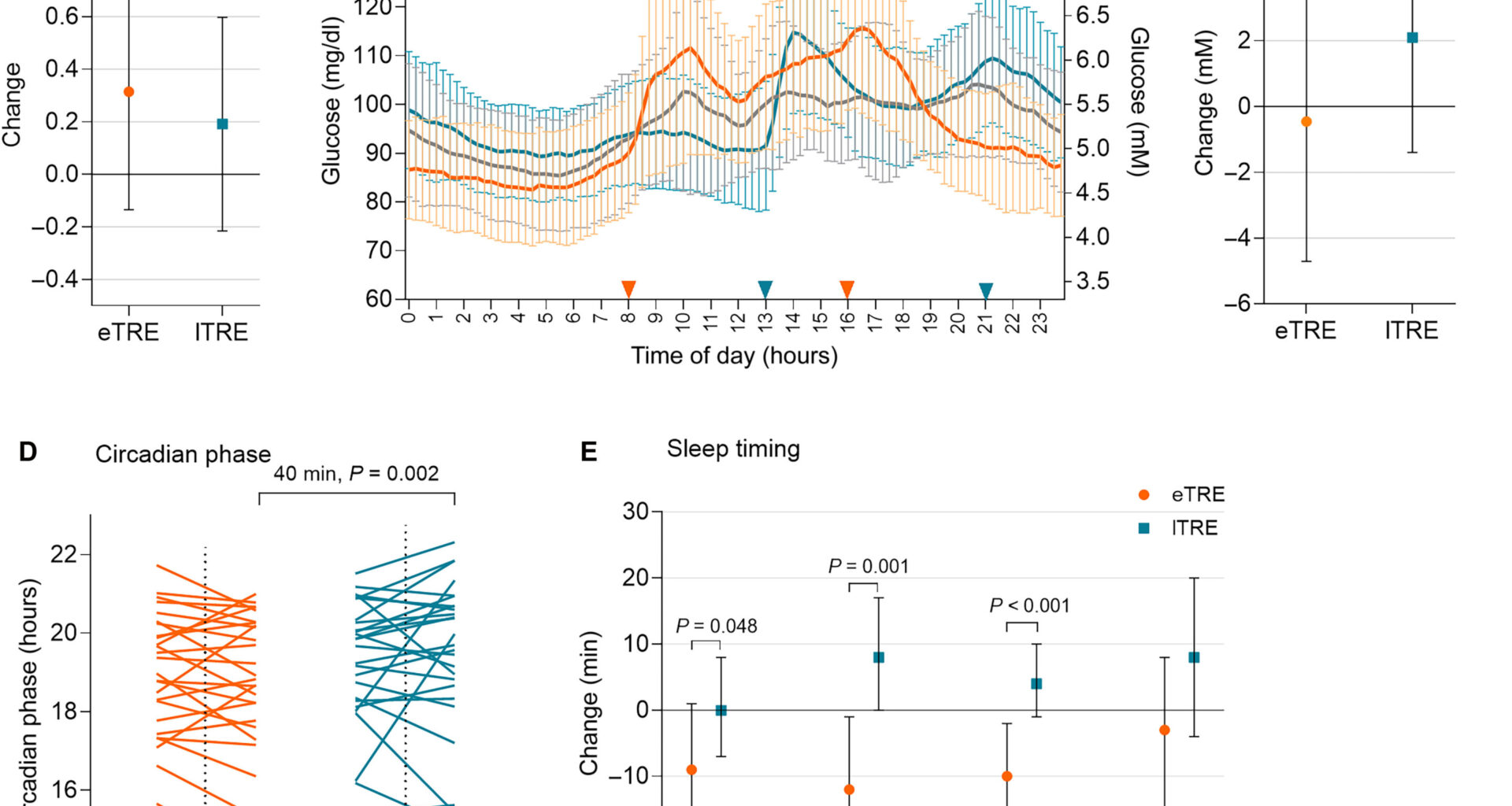
Effects of eTRE and lTRE on glucose homeostasis and circadian time. Credit: Science Translational Medicine (2025). DOI: 10.1126/scitranslmed.adv6787
Contrary to common assumptions, a new study from the German Institute of Human Nutrition Potsdam-Rehbruecke (DIfE) and Charité—Universitätsmedizin Berlin shows that intermittent fasting (time-restricted eating) with an unchanged calorie intake does not lead to measurable improvements in metabolic or cardiovascular parameters but does shift the body’s internal clocks. Prof. Olga Ramich and her team published the results of the ChronoFast study in the journal Science Translational Medicine.
Time-restricted eating (TRE) is a form of intermittent fasting characterized by a daily eating period of no longer than 10 hours and a fasting period of at least 14 hours. TRE is increasingly popular as a simple dietary strategy for weight control and metabolic health improvement. In rodents, TRE protects against diet-induced obesity and related metabolic dysfunctions.
Similarly, TRE studies in humans have suggested numerous positive cardiometabolic effects, such as improved insulin sensitivity, glucose, triglyceride, and cholesterol levels, as well as moderate reductions in body weight and body fat. Consequently, TRE is considered a promising approach to combat insulin resistance and diabetes.
Inconsistent initial situation
Results of previous TRE trials have been partly contradictory and have not yet clarified whether the metabolic improvements are due to the restriction of daily eating duration, due to spontaneous calorie restriction, or due to the combination of both factors. In fact, most previous studies have not carefully monitored energy intake or other potential confounding factors.
Therefore, Prof. Ramich, Head of the Department of Molecular Metabolism and Precision Nutrition at the DIfE as well as Professor at the Charité—Universitätsmedizin Berlin, and her team investigated whether an eight-hour eating period could improve insulin sensitivity and other cardiometabolic parameters in a tightly controlled isocaloric environment in the ChronoFast trial.
The scientists conducted a randomized crossover design involving a total of 31 women with overweight or obesity. Over two weeks each, the participants consumed their usual meals either early, between 8 a.m. and 4 p.m. (eTRE), or late, between 1 p.m. and 9 p.m. (lTRE). The calorie and nutrient composition remained nearly identical (isocaloric).
During four visits, blood samples were collected, and an oral glucose tolerance test was performed to examine the influence of TRE on glucose and fat metabolism, as well as other metabolic markers. Within the dietary phases, continuous glucose monitoring was used to observe 24-hour glucose levels while simultaneously documenting food intake. Physical activity was controlled using a motion sensor. DIfE researchers, in cooperation with Prof. Achim Kramer from the Charité—Universitätsmedizin Berlin, also studied the body’s internal clock in isolated blood cells.
No improvements in insulin sensitivity or other metabolic values
Contrary to previous studies suggesting positive effects of TRE, the ChronoFast study shows no clinically relevant changes in insulin sensitivity, blood sugar levels, blood fats, or inflammatory markers, at least following this relatively short two-week intervention. “Our results suggest that the health benefits observed in earlier studies were likely due to unintended calorie reduction, rather than the shortened eating period itself,” explains Prof. Ramich.
Although the participants showed no marked metabolic improvements, the study of the internal clock in blood cells revealed that TRE influenced the circadian phase in blood cells and the sleep timing. The internal clock was, on average, shifted back by 40 minutes after the lTRE intervention compared to the eTRE intervention, and participants who followed the lTRE intervention went to bed and awaked later. “The timing of food intake acts as a cue for our biological rhythms—similar to light,” says first author Beeke Peters.
Negative energy balance and chronotype may be crucial
The results underscore that calorie reduction plays a central role in the health benefits of intermittent fasting. “Those who want to lose weight or improve their metabolism should pay attention not only to the clock, but also to their energy balance,” summarizes Prof. Ramich.
Future studies should clarify whether a specific timing of TRE, in combination with a reduced calorie intake, provides additional benefits and how individual factors, such as chronotype or genetics, influence these effects.
Background: Determination of circadian rhythms
The human body follows an individual, molecular-mechanism-generated rhythm, which roughly corresponds to the length of a day (Latin: circa, dia), and is therefore also known as the circadian clock. According to the day-night rhythm, it reliably controls nearly all physiological and biochemical processes in the body, including sleep and metabolism.
Almost every cell in the body possesses an internal clock that can be influenced by light and other factors, such as exercise or nutrition. To objectively determine a person’s individual internal rhythms (circadian phase), Prof. Dr. Kramer developed the BodyTime assay. The test requires only a single blood sample. This method was used in the ChronoFast study and showed that eating times influence the body’s internal clocks in humans.
More information:
Beeke Peters et al, Intended isocaloric time-restricted eating shifts circadian clocks but does not improve cardiometabolic health in women with overweight, Science Translational Medicine (2025). DOI: 10.1126/scitranslmed.adv6787
Provided by
Deutsches Institut für Ernährungsforschung Potsdam-Rehbrücke
Citation:
Time-restricted eating without calorie cuts doesn’t improve metabolic health, study finds (2025, November 4)
retrieved 5 November 2025
from https://medicalxpress.com/news/2025-11-restricted-calorie-doesnt-metabolic-health.html
This document is subject to copyright. Apart from any fair dealing for the purpose of private study or research, no
part may be reproduced without the written permission. The content is provided for information purposes only.

